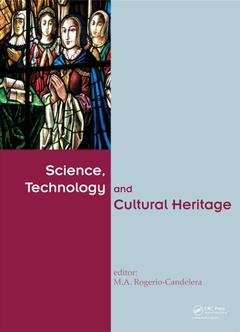Science, Technology, and Cultural Heritage: An inexorable relationship, Climate change, sea level rise and impact on monuments in Venice, Air pollution and preventive conservation in some European museums, Low cost strategies for the environmental monitoring of Cultural Heritage: Preliminary data from the crypt of St. Francesco d’Assisi, Irsina (Basilicata, Southern Italy), Monitoring moisture distribution on stone and masonry walls, Effects of open shelters on limestone decay: The case-study of the Bishop’s Palace archaeological site in Witney (England), Air quality assessment and protection treatments impact on the collection of the Museo Naval (Madrid, Spain), Establishing the relationship between underwater cultural heritage deterioration and marine environmental factors. A comparative analysis of the Bucentaure and Fougueux sites, Natural gamma radioactivity in granites with different weathering degrees: A case study in Braga (NW Portugal), Accelerated weathering test as environmental behaviour trials on metals, Painting woods vulnerability to ultraviolet exposure, Physical characterization of super-fragile materials in underwater archaeological sites, Underwater Cultural Heritage risk assessment related to mean and extreme storm events: A modelling case study in the Bay of Cadiz, Another source of soluble salts in urban environments due to recent social behaviour pattern in historical centres, Historical and experimental integrated study on brick masonry identification: Comparison of two heritage buildings in the city of Alcalá de Henares (Madrid, Spain), Physical-chemical analysis for the research and the valorisation of the oppidum of Puente Tablas (Jaén, Spain), The use of writing inks in 12th–19th century Arabic manuscripts: A study of the collection of the School of Arabic Studies, Granada (Spain), Science, Technology, and Cultural Heritage: An inexorable relationship, New nanomaterials for conservation of Cultural Heritage: Consolidants, hydrophobic and self-cleaning products, Nanosilica and nanolime on the conservation of mortars and concretes of our heritage, Effectiveness of a novel consolidant/hydrophobic nanomaterial on stones from three archaeological sites, New consolidant product based on nanoparticles to preserve the dolomitic stone heritage, Powdered Cellulose Project: Cellulosic fibres for dry cleaning and reinforcement of paper supports, Increasing surface roughness of coatings to promote high-hydrophobicity, Damage diagnosis and water repellent assessment in the Fuente Nueva of Martos (Jaén, Spain), Chromatic properties study of mortars with organic binder used in the reproduction of outdoor artworks, Epoxy resins: From industrial material to contemporary art medium, Characterisation and purification of proteic binders used in easel paintings, Tertiary bioreceptivity of Hontoria limestone: Assessment of secondary metabolites as natural biocides, Microbes, science, art and conservation, who wins the game?, Characterization of phototrophic biofilms deteriorating Indian stone monuments, their response to heat stress and development of a non-invasive remediation strategy, The effect of calcium oxalates in the weathering steel surface, Role of microorganisms in mural paintings decay, Production of novel biocides for Cultural Heritage from Bacillus sp., Phototrophic microorganisms in the tourist cave of Nerja, Analytical and microbiological characterization of 20th century photographic negatives, Characterization of old paper samples exhibiting foxing, Analysis of materials and biodeterioration study of a corn cane sculpture: Crucificado del Capítulo de Bornos (Cádiz), Fluorescence in situ hybridisation for microbiological detection in mortars, Laser Induced Fluorescence applied to diagnosis in calcareous stones, Swelling clays in stone materials of the built heritage of Córdoba (Spain), Observatory of Cultural Heritage Conservation Research, Two new species of bacteria isolated from white colonizations in Andalusian caves, Application of THz-TDS imaging technology to the investigation of panel paintings, Panel painting by Cristobal de Morales analysed by non-destructive XRF technique, The Mayan stucco masks from Edzná: Material characterization and analysis of the environmental influence on their deterioration, Detection of starch and organic dyestuffs as painting materials in a series of 18th century paintings by Zacarías González Velázquez using a HPLC-DAD-QTOF system, Late middle age painting canvas of the Our Lady of Rosary: A study of its materials and techniques, Impact assessment of different cleaning methods for tarnished silver artefacts, Detection of proteic binders in easel paintings using monoclonal antibodies, Study of the influence of black dyes in the physico-mechanical behaviour of silk fabrics. II. Influence of UV-light artificial aging, Estimating the firing temperature of ancient pottery by combining TL and other usual techniques, Archaeometric study of porcelains of the National Spanish Museum of Archaeology, Weathering maps assisted by Digital Image Analysis and Autocad, 3D study of Cultural Heritage for conservation: Reliability of portable 3D laser scanner, The representation of Cultural Heritage: Methodologies for digital characterization, Building features and safeguard of church towers in Basilicata (Southern Italy), Remote sensing for the study, protection and conservation of Cultural Heritage: The experience of ITACA Mission in Southern America (2007–2013), Artworks in high-risk context: Integrated and low cost approach to theft and dispersion protection, Spatial analysis for archaeological predictive models: Preliminary results for the Roman Age in the Basilicata Region, The “Sassi of Matera” site: Preliminary results from the investigation on the weathering forms through on-field surveys and spatial analysis, Development and implementation of the MHS algorithm for the preventive conservation of heritage monuments, Comparative study of Roman counterfeit coins: A multi-technique approach, Integrating non-destructive techniques with photogrammetry 3D models for the development of Geographic Information Systems in heritage structures, Project 3D-ICONS: The Iberian heritage at the European Digital Library, The Antiqvarivm of Seville, new landmark of cultural heritage in Seville, Enhancement of the historical “Royal Quicksilver Way”, Approaches to restoration project of monuments and historical sites in Southern Italy, The dialogue between stone and environment: Learning from practice, Public vs. private rehabilitation management strategies—the Almeida Manège and the Fronteira Palace, The Cloister—a unique space, New vulnerability approach for monument diagnosis, Sensing technologies for monitoring and conservation of Cultural Heritage: Wireless detection of decay factors




